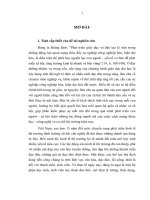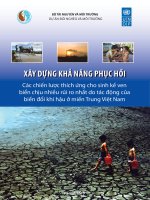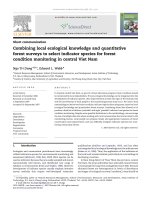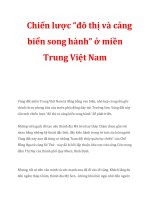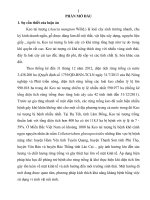loài chỉ thị để theo dõi trạng thái rừng ở miền Trung Việt Nam
Bạn đang xem bản rút gọn của tài liệu. Xem và tải ngay bản đầy đủ của tài liệu tại đây (136.23 KB, 4 trang )
Short communication
Combining local ecological knowledge and quantitative
forest surveys to select indicator species for forest
condition monitoring in central Viet Nam
Ngo Tri Dung
a,b,
*
, Edward L. Webb
a
a
Natural Resources Management, School of Environment, Resources, and Development, Asian Institute of Technology,
P.O. Box 4, Klong Luang, Pathumthani 12120, Thailand
b
Faculty of Forestry, Hue University of Agriculture and Forestry, 102 Phung Hung Street, Hue City, Viet Nam
1. Introduction
Ecologists and conservation practitioners have increasingly
utilized indicators species for environmental monitoring and
assessment (McGeoch, 1998; Kati, 2003). Plant species can be
used as indicators because they are easily sampledand stored,
taxonomically well known, and distributed over range of
habitats or environments (Faith and Walker, 1996). However,
development of indicator species usually employs intensive
survey methods that require well-developed researcher
qualifications (Dufreˆne and Legendre, 1997), and has often
not integrated local ecological knowledge intothe indicator set
(Salam et al., 2006). Thus, the application of the indicators at
the local level remains limited, particularly in rural settings of
developing countries.
In Nam Dong district of Thua Thien Hue province, central
Viet Nam, the local authorities have allocated natural forests
to local people for long-term management since 2001. Because
allocated forests are heterogeneous in levels of disturbance
and stages of ecological recovery (‘condition’), they should be
ecological indicators 8 (2008) 767–770
article info
Article history:
Received 4 December 2006
Received in revised form
3 September 2007
Accepted 18 September 2007
Keywords:
Degradation
Disturbance
Participation
Regeneration
Succession
Tropical forest
Tree community
abstract
In tropical central Viet Nam, as part of a forest allocation program, forest condition should
be monitored by local stakeholders. If local ecological knowledge can be integrated into the
development of indicator species, then improvements in both the rigor of the indicator list
and the involvement of local peopl e in the monitoring process may occur. We used a dual
methodology to derive two forest condition indicator species lists using trees, based on local
ecological knowledge and quantitative forest surveys. Combining these lists allowed us to
produce a final list of thirteen ‘probable’ and eight ‘possible’ indicator tree species for forest
condition monitoring. Despite some possible limitations to the methodology, we encourage
the use of multiple data sets when working with rural communities that are involved in the
monitoring process. Local people can propose timely and appropriate measures of forest
conservation and improvement, and can definitely integrate indicator species into mon-
itoring community forests.
# 2007 Elsevier Ltd. All rights reserved.
* Corresponding author at: Natural Resources Management, School of Environment, Resources, and Development, Asian Institute of
Technology, P.O. Box 4, Klong Luang, Pathumthani 12120, Thailand. Tel.: +84 54 529137; fax: +84 54 524923.
E-mail address: (N.T. Dung).
available at www.sciencedirect.com
journal homepage: www.elsevier.com/locate/ecolind
1470-160X/$ – see front matter # 2007 Elsevier Ltd. All rights reserved.
doi:10.1016/j.ecolind.2007.09.002
monitored regularly to collect information for appropriate
management practices. Developing a list of indicator species
based on local ecological knowledge and quantitative vegeta-
tion plot data could contribute to long-term forest monitoring
since these two sources of information help to increase the
statistical rigour of those indicators. This would also improve
levels of interest and confidence of local people when
monitoring forests that are under local community control.
In this study we combined local ecological knowledge with
quantitative vegetation data to propose a set of forest
condition indicator species of trees for tropical forest in
Nam Dong district, Viet Nam.
2. Materials and methods
Nam Dong district is located in southwestern Thua Thien Hue
province in central Viet Nam. The district ranges in elevation
from 300 m to 1700 m above sea level, and approximately 65%
of the district is covered with seasonal evergreen broadleaf
forest (Tordoff et al., 2003). Three communes selected for this
study were Thuong Quang, Thuong Long, and Huong Son.
Major livelihood activities were paddy agriculture, swidden
agriculture, non-timber forest product (NTFP) collection and
small wildlife hunting. Based on a combination of the
government forest classification system and local descrip-
tions, we classified forests into three groups. Relatively intact
forest (RIF) had a closed canopy, well-defined stratification,
and the majority of large trees with a stem diameter greater
than 20 cm. Selectively logged forest (SLF) had been logged and
exhibited a significantly altered structure from RIF. Swidden
forest (SWF) had regenerated after swidden agriculture or
clear cutting since a logging ban was implemented in 1995.
Most of the allocated forests have been RIF and SLF, with small
areas of SWF allocated for plantation or upland crop
cultivation (cassava, maize, and upland rice).
In order to develop a list of indicator species for these three
forest types, we collected complementary sets of qualitative
and quantitative data. Qualitative data were obtained through
village meetings and questionnaire interviewing of 118
experienced local people (woodsmen). Species were ranked
for each forest type according to respondent value (ResVal),
which was the percent of respondents listing that species as
being exclusively or nearly exclusively found in one of the
three forest types (i.e., an indicator).
Quantitative data were collected from 110 circular plots
established across the three forest types, across the three
study communes. Each plot had a radius of 10 m and was
placed randomly. We did not survey woody seedlings or
climbers because they were not comparable to the locally
derived indicator list, which focused on life forms larger than
seedlings. Taxonomy followed Ho (2000) and the Plant Name
Table 1 – Probable and possible indicator species for relatively intact forest (RIF), selectively logged forest (SLF), and
Swidden forest (SWF) in Nam Dong district of Central Viet Nam
Forest type Species name Family Life form Local ecological
knowledge
Plot data
ResVal Rank IndVal Rank
Probable indicator species
RIF Hopea pierrei DIPTEROCARPACEAE L-tree 69.5 1 25.0 10
Gironniera subaequalis ULMACEAE M-tree 22.9 7 49.4 1
Palaquium annamense SAPOTACEAE L-tree 17.8 9 43.9 2
Syzygium sp. MYRTACEAE S-tree 21.2 8 39.4 3
Rhapis laosensis ARECACEAE Palm 28.8 6 11.7 21
Madhuca pasquieri SAPOTACEAE L-tree 13.6 10 28.0 7
SLF Horsfieldia amygdalina MYRISTICACEAE L-tree 18.6 1 38.5 7
Gardenia annamensis RUBIACEAE S-tree 15.3 3 35.9 8
Garcinia cochinchinensis CLUSIACEAE M-tree 10.2 6 26.2 16
SWF Mallotus paniculatus EUPHORBIACEAE M-tree 59.3 2 77.8 1
Macaranga denticulata EUPHORBIACEAE S-tree 16.9 7 70.2 2
Thysanolaena maxima POACEAE Grass 67.8 1 22.2 6
Melastoma candidum MELASTOMATACEAE Shrub 38.1 4 28.4 4
Possible indicator species
RIF Erythrophleum fordii CAESALPINIACEAE L-tree 45.8 2 – –
Parashorea stellata DIPTEROCARPACEAE L-tree 42.4 3 – –
SLF Scaphium lychnophorum STERCULIACEAE M-tree – – 61.2 1
Knema pierrei MYRISTICACEAE L-tree – – 54.4 2
Croton cascarilloides EUPHORBIACEAE Shrub – – 50.6 3
Ampelocalamus patellaris POACEAE Bamboo 16.1 2 – –
SWF Scleria levis POACEAE Grass – – 66.1 3
Imperata cylindrica POACEAE Grass 52.5 3 – –
Respondent values (ResVal) and indicator values (IndVal) were listed from local interview data and plot survey data, respectively. L-tree: large
tree (>30 m high); M-tree: medium tree (15–30 m high); S-tree: small tree (<15 m high).
ecological indicators 8 (2008) 767–770768
Index of Viet Nam (IEBR and CRES, 2003). From plot data, the
indicator value (IndVal) of each species was calculated using
the method of Dufreˆne and Legendre (1997). This method
combined information on the concentration of species
abundance in a particular forest type (specificity) and the
faithfulness of occurrence of a species in a particular forest
type (fidelity). The IndVal may range from zero (no indication)
to 100 (perfect indication). PC-ORD software (version 4.41,
McCune and Mefford, 1999) was used to calculate the IndVal
for each species.
We constructed two final lists of indicator species based on
(1) the overlap between interview-derived and plot-derived
data for each species, and (2) the rank of that species in each
data type. A ‘probable indicator species’ was one that
appeared in both sources of data for that forest type and
had high IndVal or ResVal for at least one data set. A ‘possible
indicator species’ appeared in only one source of data but had
an IndVal or ResVal rank in the top three for that forest type.
3. Results
Thirty-two species were identified by local people as indica-
tors, with 15 for RIF, 9 for SLF, and 8 for SWF. The top locally
known indicator species for RIF were Hopea pierrei, Erythroph-
leum fordii, and Parashorea stellata. Local indicators for SLF were
Horsfieldia amygdalina, Ampelocalamus patellaris, and Gardenia
annamensis. Top local indicator species for SWF were Thysa-
nolaena maxima, Mallotus paniculatus and Imperata cylindrica.
Analysis of plot data yielded 21 indicator species for RIF, 30
for SLF and 15 for SWF. The top plot-derived indicators for RIF
were Gironniera subaequalis and Palaquium annamense. Top
indicator species for SLF were Scaphium lychnophorum, Knema
pierrei and Croton cascarilloides. In SWF, indicator species were
M. paniculatus, Macaranga denticulata and Sclera levis.
Comparing the interview data with the plot data returned
13 probable indicators and eight possible indicators (Table 1).
H. pierrei, G. subaequalis, and P. annamense appeared to be the
strongest probable indicators for RIF because they had both
high ResVals and high IndVals. Probable indicator species for
SLF included H. amygdalina, G. annamensis, and Garcinia
cochinchinensis. SWF probable indicators were M. paniculatus,
M. denticulata, T. maxima, and Melastoma candidum. Seven
species were possible indicators across the three forest types
including E. fordii (RIF), S. lychnophorum, K. pierrei, C. cascar-
illoides and A. patellaris (SLF). Two possible indicator species for
SWF were Scleria levis and I. cylindrica.
4. Discussion
There are two indicandum for which indicator species can be
used in monitoring levels of forest condition. First, early
warning of forest degradation can occur over time if the
abundance of SWF or SLF indicators increases while the
abundance of RIF indicators declines. In contrast, recovery of
degraded forest can be interpreted over time if the abundance
of RIF indicators increases and the abundance of SWF or SLF
indicators decreases. While a wide range of species may
regenerate (establish) across forest types owing to dispersal
(e.g. M. denticulata in RIF, G. subaequalis in SLF), when data are
aggregated across a sufficient sample size and collected
repeatedly over time, significant changes in frequencies of
indicator species should indicate changing overall forest
conditions. This could be even more powerful if individuals
of indicator species are tagged and monitored to calculate
survival and size class transition rates. Seedlings and saplings
could be included in the data set if favorable conditions for
their growth are known.
Various factors could influence the amount of overlap or
mismatch between locally derived and plot-derived indicator
lists. First, some species listed by local people as important
indicators for a particular forest type may be ecologically
transient and present only for a short period of time, and thus
rarely encountered in quantitative plots. Examples in this
study were Crassocephalum crepidioides and Eupatorium odor-
atum (both local SWF indicators). Second, humans may alter
the populations of potential indicator species, such that
present and future capacity of that species to indicate trends
in forest condition is compromised. E. fordii and P. stellata are
large, commercially valuable timber species that were listed as
indicators by local people, but had been heavily logged in the
study area and were nearly absent from quantitative plots.
Third, local use of a species may influence people’s listing of it
as an indicator, with more valuable or commonly utilized
species attaining higher prominence than more ecologically
responsive species, in local observations of abundance in the
forest. These three factors may have affected the amount of
agreement in locally derived and plot-derived indicator
species lists.
The results of this study suggest that indicator species
may represen t a cost-effective method for monitoring
by local people. Care must be taken when interpreting
reasons for mismatching of indicator lists. Despite possible
sources of confusion and imprecision, we encourage the
useofmultipledatasetswhenworkingwithruralcomm-
unities that are i nvolved in the monitoring process. Local
people can propose t imely and appropriate measures of
forest conservation and improvement, and can definitely
integrate indicator species into community forest monitor-
ing activities.
Acknowledgements
We thank Tran Nam Thang, Ho Dinh Tuan, and Tran The Nhan
at the Faculty of Forestry, Hue University of Agriculture and
Forestry for their contribution in collecting data and discus-
sion. This study was supported by a grant from the John D. and
Catherine T. MacArthur Foundation to the Asian Institute of
Technology.
references
Dufreˆne, M., Legendre, P., 1997. Species assemblages and
indicator species: the need for a flexible asymmetrical
approach. Ecol. Monogr. 67 (3), 345–366.
Faith, D.P., Walker, P.A., 1996. How do indicator groups provide
information about the relative biodiversity of different sets
ecological indicators 8 (2008) 767–770 769
of areas? on hotspots, complementary and pattern-based
approaches. Biodivers. Lett. 3, 18–25.
Ho, P.H., 2000. Cay Co Viet Nam. An Illustrated Flora of Viet
Nam, 3 volumes. Youth Publishing House, Ho Chi Minh City
(in Vietnamese).
Institute of Ecology and Biological Resources (IEBR) and Center
for Resources and Environmental Studies (CRES), 2001–2003.
Danh Luc Cac Loai Thuc Vat Viet Nam (The Plant Name
Index of Viet Nam), 3 volumes Agricultural Publishing
House, Hanoi.
Kati, V., 2003. Testing the value of six taxonomic groups as
biodiversity indicators at a local scale. Conserv. Biol. 18,
667–675.
McCune, B., Mefford, M.J., 1999. PC-ORD. Multivariate Analysis
of Ecological Data, Version 4. MjM Software Design,
Gleneden Beach, Oregon, USA.
McGeoch, M.A., 1998. The selection, testing and application of
terrestrial insects as bioindicators. Biol. Rev. 73, 181–201.
Salam, M.A., Noguchi, T., Pothitan, R., 2006. Community forest
management in Thailand: current situation and dynamics
in the context of sustainable development. New Forests 31,
273–291.
Tordoff, A., R. Timmins, R. Smith, and Vinh, M.K. 2003. A
Biological Assessment of the Central Truong Son
Landscape. Central Truong Son Initiative. Report No. 1,
WWF Indochina, Hanoi, Viet Nam.
ecological indicators 8 (2008) 767–770770
